Ever since the Damallsvenskan was formed back in 1988, Rosengård have been one of the leading sides in the division, with them consistently challenging at the top of the table and racking up 13 titles, which still remains the record to this day and makes them the most successful team in the Swedish women’s game.
It would be, therefore, widely expected that the Malmö-based team are the ones that every other side wants to beat, and that would be true in any other year. However, in 2023, things have not been quite so positive for them, with their performances appearing laboured at times and results arriving inconsistently. The fact that they have spent most of the campaign languishing in mid-table and are currently 10 points off leaders Hammarby with six matches left to play illustrates how disappointing a year has been for them.
The question on the lips of many is what has gone wrong this season and how they have fallen so far down the standings. This tactical analysis will provide some answers by breaking down the key areas of their game that have been letting them down, such as their slow transitions, lack of cutting edge in attack, and openness at the back.
Slow build-up play
When watching Rosengård play football, what immediately stands out is that they have a very possession-orientated approach to their games, with their tactics built around their heavy focus on retaining the ball and not taking too many risks when trying to move it around the pitch.
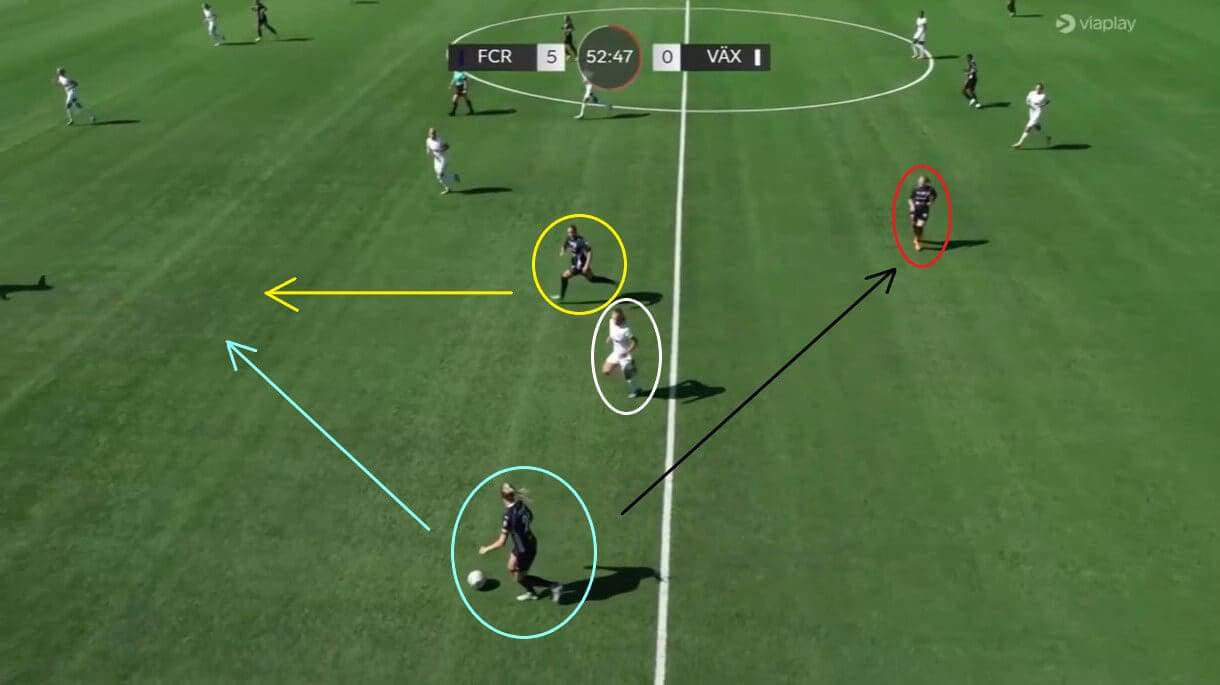
That is an admirable mindset to have and should be commended, as it means that Rosengård always control the flow of their games and never allow their opponents to dominate them. However, what is also clear is that playing this way only really benefits a team if they then use that time that they have in possession to put opponents under pressure and to force mistakes, and, unfortunately for Rosengård, this is where they have not shown enough conviction and quality.
Instead, situations like this have been prevalent in their play, with the ball in a good position and Swedish midfielder Olivia Schough having an option to play the ball forwards due to Finland midfielder Ria Öling making a run on her inside but opting instead to pass backwards towards Emma Jansson, as the black arrow shows, meaning that all of the momentum that had been built up until this point has been instantly removed.
Again, this is in aid of keeping the ball and not taking risks, which is a good thing, but the opportunity was there for Schough to keep the pressure on Växjö, who had not really pressed the ball here and who had allowed her time to control it and to pick her pass, by sending it forwards. Instead, she took the pace out of their play, let the opposing side track back, and set up in their shape, which is the critical issue here.

Another problem that Rosengård have often experienced is an overreliance on the wide channels when building attacks, with them constantly moving the ball towards those areas and then trying to use them to find ways into the middle.
Again, this is not a bad tactic to have, but Rosengård don’t tend to benefit from it due to the sluggish nature of their play, with Jansson capable of sending the ball in here but deciding instead to double back and pass the ball to Sofie Bredgaard, as the blue arrow indicates.
This again slows the play down, but it also makes Rosengård easy to defend against, with a key coaching point always being to shepherd opposing attackers out to the wings rather than allowing them to progress through the central channel. This is because defenders always find it easier to block attempted crosses once out on the wings rather than engage in 1-v-1 duels in the middle. So, the best way for any team on the offensive to prevent that from happening is to send the ball into the goal area as early as possible.
In this case, Rosengård didn’t do that, and moments like this show why they have been a lot less potent in 2023 so far, with them averaging just 2.2 goals per game compared to 2.79 in 2022.
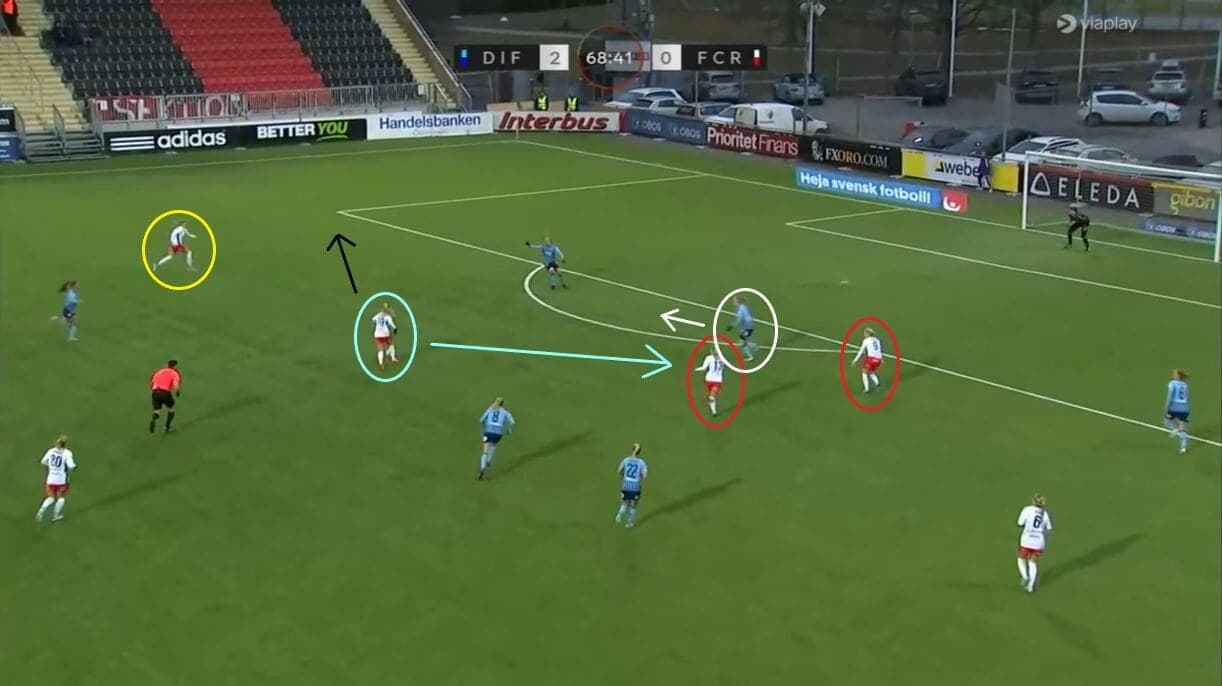
Their desire to use the wings has also led to poor decision-making at times, with them again not making the most of their opportunities and instead letting their opponents off when in threatening areas.
In this case, they pressed well from the front through Öling and forced Djurgårdens into making an error, which came when Kamilla Karlsen passed out and saw the ball regained by Olivia Holdt, who then sent it into the middle for Bredgaard to control and set up a shot on goal.
Bredgaard has two options that she can select from here, with one being to move the ball through the middle towards Holdt and Emilia Larsson, who are positioned on the edge of the goal area, and the second being to use the oncoming Schough, who is moving up the far side of the field to stretch the play.
It would be expected that Bredgaard would take a second to assess both possibilities and that she would recognise how Djurgårdens captain Sanna Kullberg is drifting away from Holdt and Larsson, leaving them with a clear view of goal, and so would send the ball towards them to catch the defensive line out.
However, the Denmark midfielder ignores all of that and instead angles her body immediately to pass the ball towards Schough, which proves to be a mistake due to the playmaker not having the same sight of goal and, therefore, unable to convert the chance. Given that Rosengård ended up losing this match 2-1 and were playing a team who have proven to be the undoing of some of those chasing Champions League places this season, scoring when they got into these positions was necessary, and not making the most of these moments prevented them from taking a valuable point.
Defensive errors
However, it is not only issues in possession that Rosengård have experienced this season because their defensive play has been just as damaging, with structural deficiencies and individual mistakes both to blame for what is increasingly likely to be a joyless campaign.
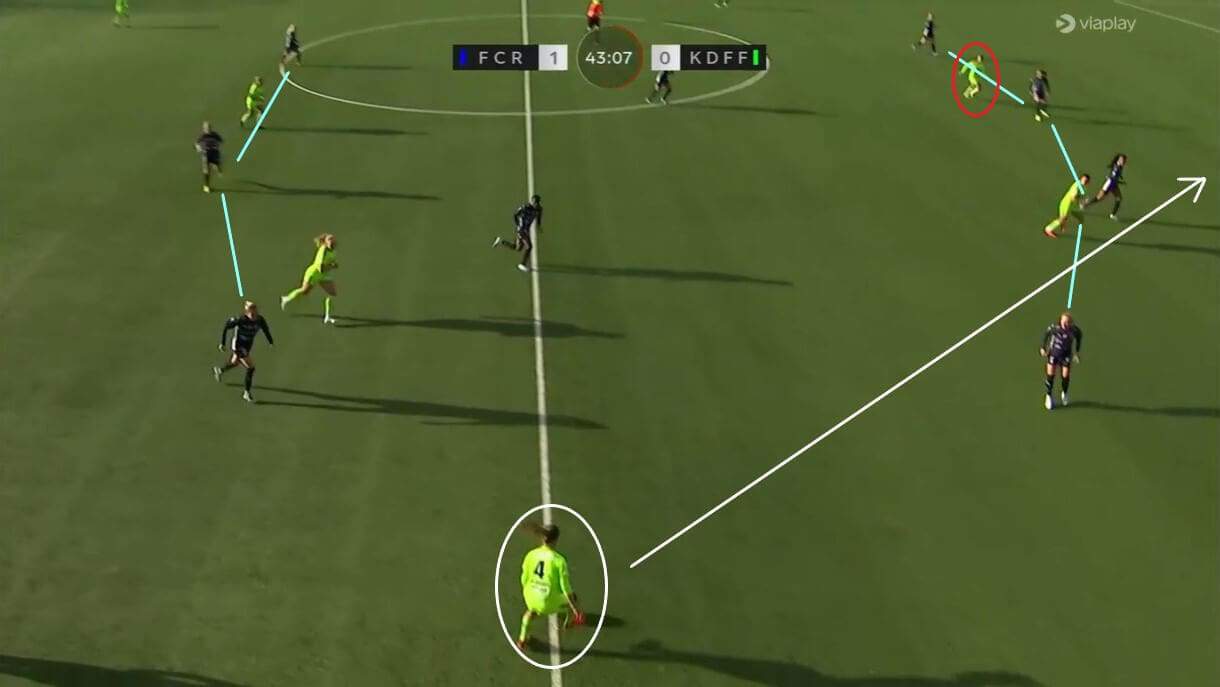
Looking first at Rosengård’s basic shape whenever they don’t have the ball, there have been some eyebrows raised at the way that they have approached this side of the game, with them tending to pull their forward line back and not press from the front that often whilst retaining a high back line.
As a result, they have tended to congregate around the middle of the pitch and have left acres of territory open behind them, which has invited opponents to instigate their own passing sequences and to target those spaces. In this case, Kristianstads took them up on it. They are not a team to give these opportunities too, with them not being among the title chasers but having some dangerous players in their side this season, with Canada striker Evelyne Viens one in particular who stood out after scoring 12 goals before moving to Roma Femminile over the summer.
On this occasion, Dutch defender Sheila van den Bulk didn’t hesitate to send the ball through a gap in the Rosengård defensive line. It allowed Viens’ strike partner Tabby Tindell to run towards the goal, and the fact that she failed to find the net was unfortunate and was a big let-off for the 13-time champions.
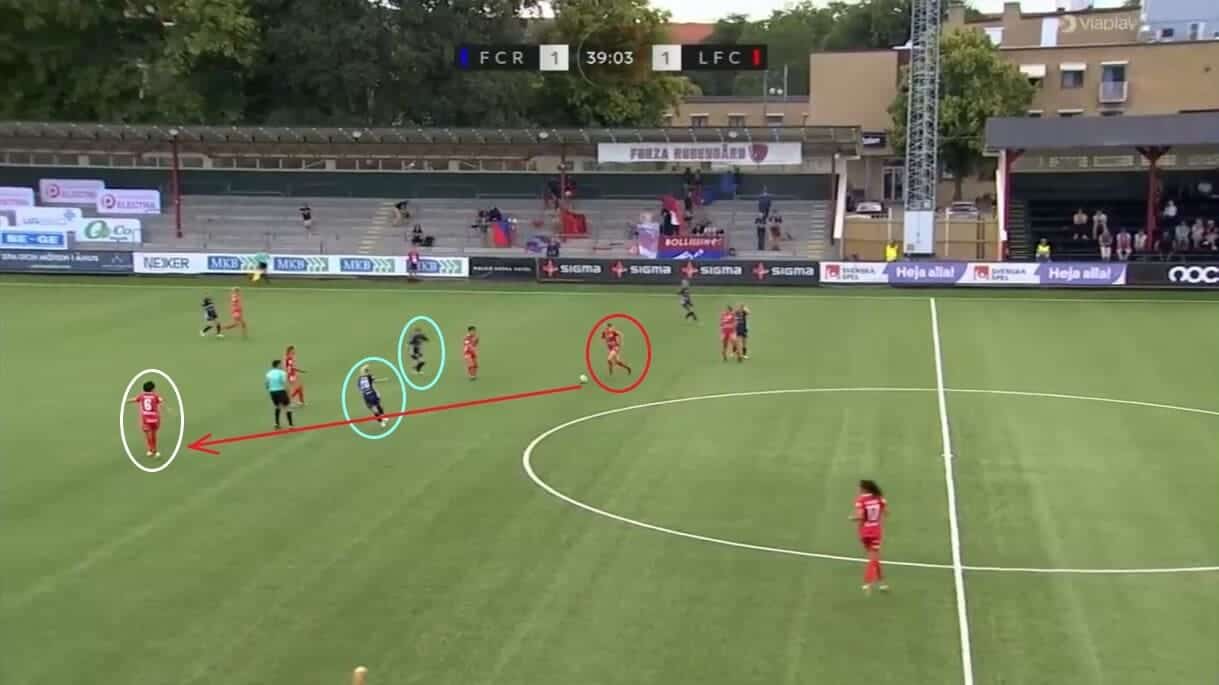
That theme of having a questionable shape continues when analysing how they set up to keep the ball between themselves and their goal, with this situation against Linköping showing another aspect of their defensive play that has often let them down. Again, the back four are too high up the field, but the players to look at here are Öling and Mia Persson, who are positioned just in front of them.
Once the ball moves out to the edge of Rosengård’s half, they look to rotate with each other to make the team as unpredictable as possible, with the intention being that Linköping defender Emma Östlund would not be able to plan her pass with as much precision as she would have liked to and so increasing the chance of her giving the ball away.
This is not the only time that they have instigated these movements, but it has never assisted them as they would have hoped. It has instead arguably made them even easier to break down, with Östlund waiting until both players had moved too far to their left and then feeding the ball through to Japan midfielder Saori Takarada without Rosengård being able to make an interception.
At that point, it became about setting up the shot on goal, which Takarada did by playing a simple pass through to Cornelia Kapocs, and the league’s joint-top scorer did not need a second invitation to find the top corner.
This goal did not look likely to come about on initial glances and only really happened because Rosengård allowed it to through their structure, and that again shows how a lack of coherency and shape is a crucial reason for them being too easy to score against and failing to challenge at the top of the league in 2023.
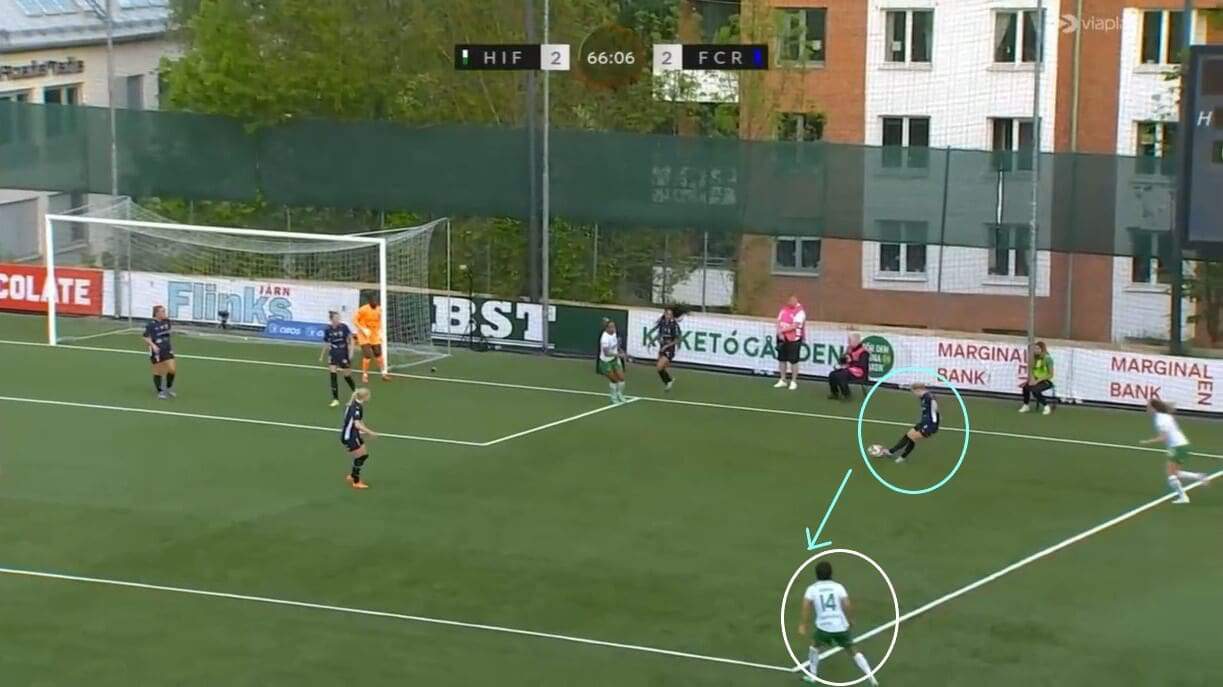
However, it would be remiss to state that tactical issues are the only thing that have hindered Rosengård’s title hopes this season and that have led to them conceding more goals per game than in 2022 (0.93 last year compared to 1.15 in the current one), with individual errors also letting them down consistently as the campaign has gone on.
Here, Hammarby have found their way into Rosengård’s half through good combination play by Emma Westin and on-loan Chelsea Women and Japan forward Maika Hamano and have seen a shot by Madelen Janogy come off the post. Rosengård move the ball back out towards the wing.
At this point, it should have been easy for Larsson to clear her lines and to end the threat, but she instead tries to play out from the back, as is another crucial aspect of Rosengård’s tactics and sees her pass go straight back to Hamano. As a result, Hammarby are gifted a chance to try again, with the Japanese forward seeing her effort deflected just wide here and go out of play for a corner.
Suppose Rosengård are to correct their poor form and start challenging at the top of the table again. In that case, these are the moments that they have to do better in because not doing so means they are constantly putting themselves under unwanted pressure and allowing opponents to play to their own strengths. In this case, that is Hammarby’s rapid transitions and incisive passing, with the likes of Hamano, Janogy and now-Arsenal Women midfielder Kyra Cooney-Cross all involved in their ability to play through opponents and to use their lapses in concentration against them.
Positive aspects
Even though Rosengård’s play has left a lot to be desired, it has not all been bad, and there have been a few signs here and there that they can still save their season and make up the gap between themselves and the top three (who qualify for the Champions League). It should be remembered that, despite not winning as many games, they have only incurred four defeats, and so, whilst consistent victories have eluded them, teams are still finding it hard to beat them outright.

One of those signs is in their transitional play because, despite the lack of intensity shown earlier in the scout report when it comes to how they move the ball around the field, there have been occasions when they have demonstrated that they have what it takes to play quicker football and to break their opponents down.
This situation shows the threat they pose when they play with more decisiveness, and what might surprise some is that this is actually from the same game as Schough’s hesitant play at the beginning of the analysis. However, this time, the Swedish forward is only involved at the end of the move. Instead, Holdt and Jansson are responsible for building the play, and both are much more comfortable with testing Växjö’s backline to find their weak points with early passes.
Rosengård ended up beating Växjö very comfortably in the end, with the final scoreline reading 7-1 in their favour, and that was largely down to some members of the team being brave and doing what Schough needed to in the previous example. However, the fact that others can string together these quicker transitions does show that Rosengård can play with more pace when they want to, and the fact that it yielded results here shows what is possible when they have that self-belief.
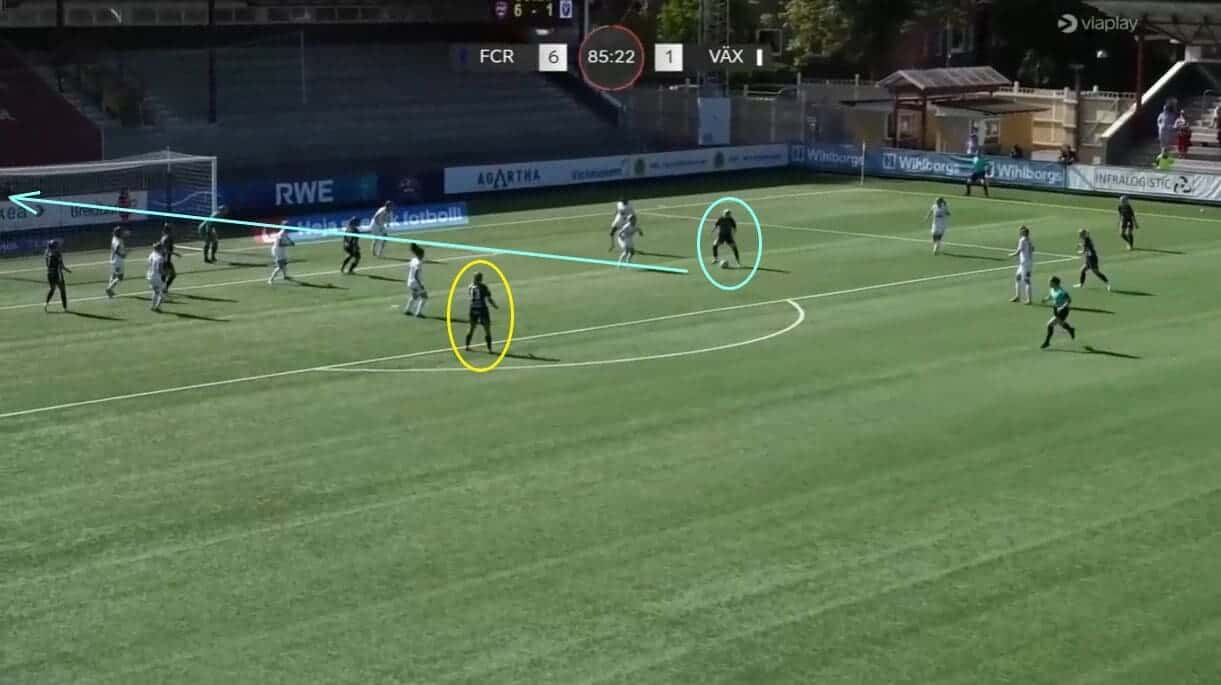
The fact that some in the team are more decisive than others is also clear to see here, with Larsson inside the Växjö goal area after receiving a cross-field pass from Loreta Kullashi and playing a one-two with Bredgaard.
At this stage, her options are to either pass the ball backwards, with Holdt in a position to receive it on the edge of the box, or to shoot at goal herself, and Larsson does the latter here and finds the top corner.
The fact that Växjö didn’t respond and look to close her down is perhaps a reflection that they weren’t expecting the shot to come here, having witnessed the low speed of some of Rosengård’s attacks at other points in the game. Still, the fact that this chance came off shows again how, when they put their minds to it and decide to have a go, Rosengård can get goals, wins and points on the board.
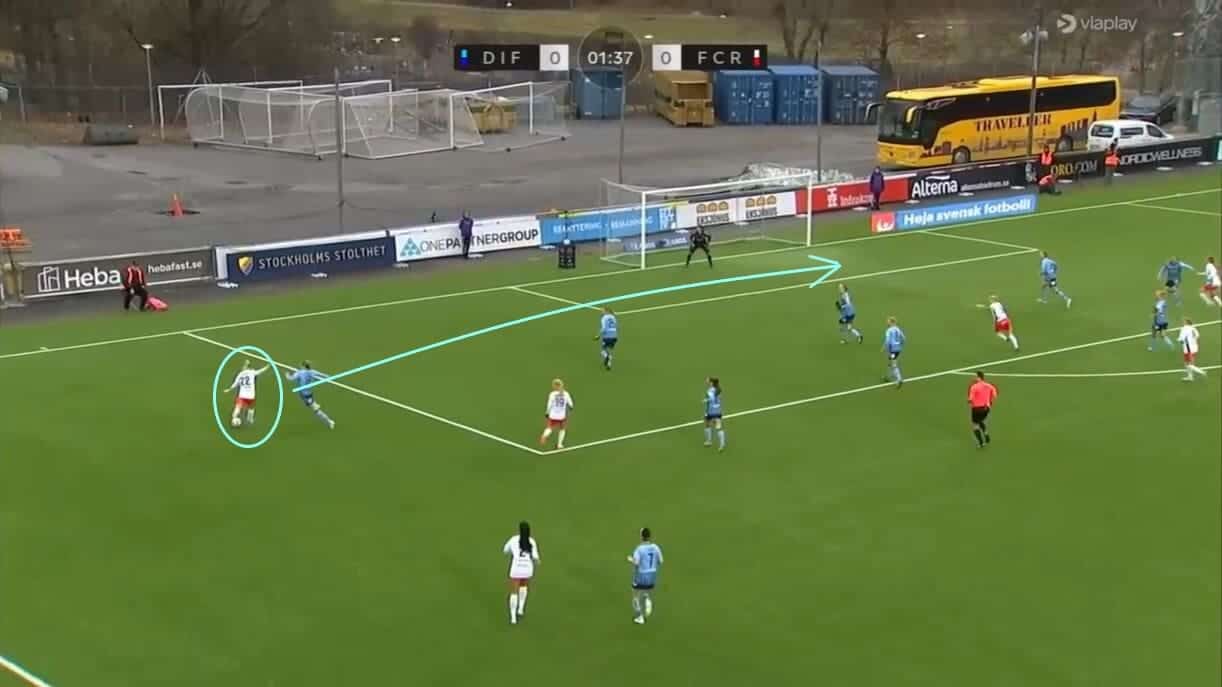
The fact that there are some games where they aren’t scoring goals and the fact that they are, on average, finding the net less per game will be seen as a problem by the players and coaching staff alike, and it is certainly something that will need addressing as quickly as possible.
However, it would be even more concerning if they weren’t creating chances, and the fact that they are and are moving the ball into promising positions is a positive. It will give them a reason to keep pushing and trying to increase their productivity during the remainder of the campaign.
In this case, Schough has taken the ball beyond the Djurgårdens back line and has sent the ball into the middle, and what prevented this from being turned into the net is that none of her teammates in the middle reacted in time, so the defenders were able to reach the ball first. However, this can be quickly addressed through practice on the training ground to ensure that the right runs are being made and chances like this are being capitalised on.
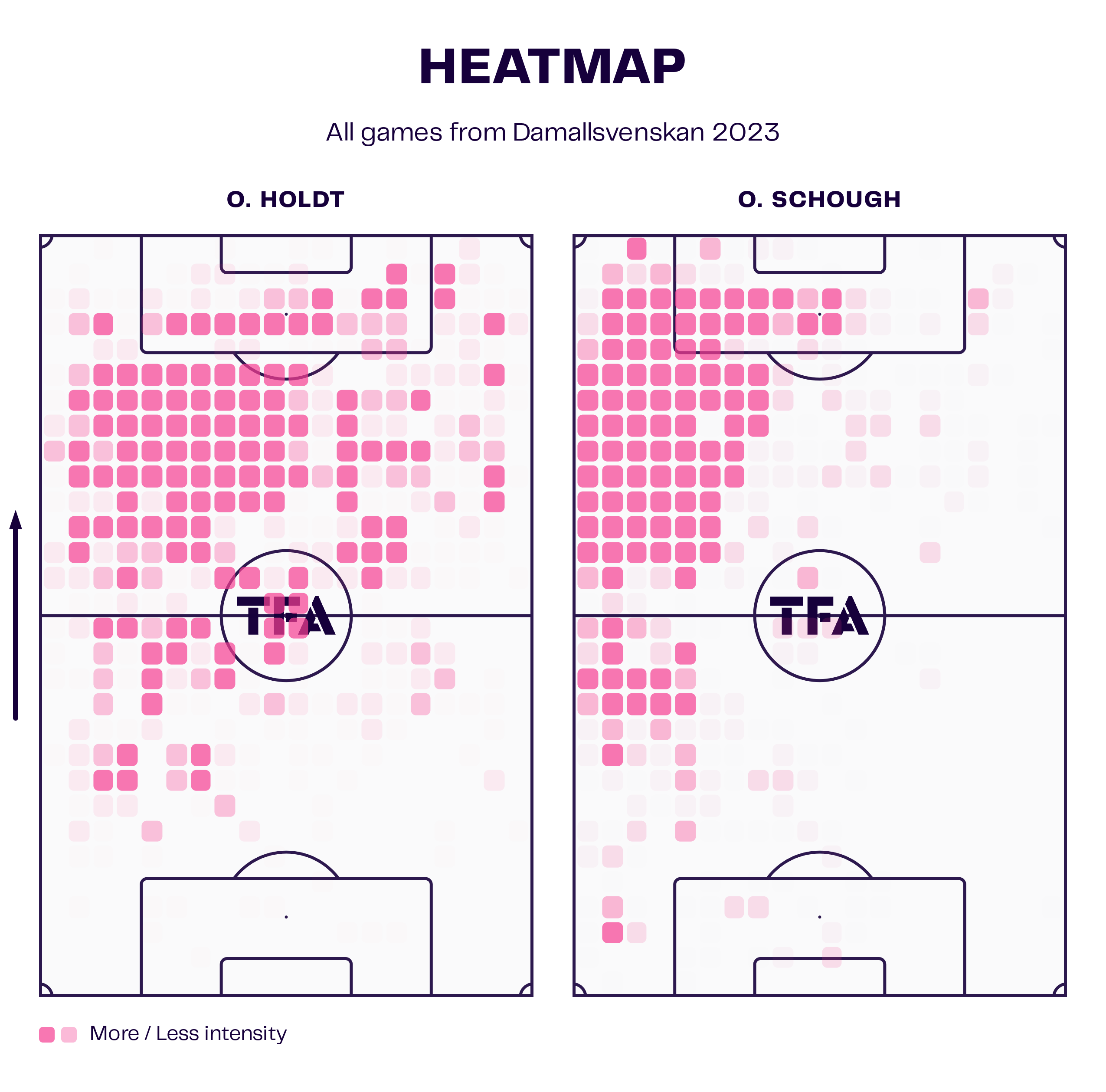
It may also require a dip into the transfer market, with Rosengård’s attacking play this season relying on rotations and players dropping back and then moving forward, just as the intention was here. That has worked for some players, with Schough and Holdt their top scorers this season so far with 12 and 10 goals, respectively, but the fact that they cover so much ground, as indicated by their heatmaps, means that they can’t always be there when the ball does get into these positions.
Therefore, adding a focal point to stay higher up the field could be a good move, as it would allow Schough and Holdt to continue contributing inside the final third. Still, it would also mean that more chances were being converted, which could be what turns the tables for Rosengård and allows them to regain their confidence and start climbing again.
Conclusion
In conclusion, this tactical analysis has looked in detail at Rosengård’s performances during the 2023 Damallsvenskan season, picking out the reasons for their underperforming, compared to their usual standards, and sitting seventh and a long way off the summit.
What has been evident throughout the scout report, though, is that a lot of what has been going wrong is recoverable, with work on the training ground to address some of the problems raised and potential transfer business both capable of fixing what is currently not working or which needs some rethinking.
If Rosengård can mend some of these issues quickly, 2023 may not be over just yet for them, but 2024 does seem like a more realistic target for them to get back to challenging for the Damallsvenskan trophy. It could well be that the experience of falling away as they have done this year will be a blessing in disguise, potentially giving them added vigour and a renewed desire in their quest for silverware. It will be worth watching them to see if they can regain their place at the top of the league in a year.





Comments